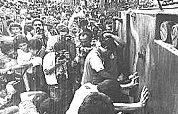

Third Republic
The Republic of the Philippines was
formally proclaimed on July 4, 1946. In addition to the problem of economic rehabilitation,
the new state was faced with internal strife. In central Luzon the Hukbalahaps, or Huks,
a Communist-led group of former guerrillas against the Japanese, organized a rebel government,
with its own military, civil, and administrative procedures. Demanding collectivization of farmlands and the
abolition of tenant farming, the Huks became a powerful force in Luzon.
The Reformation
In 1953, the government attempted
unsuccessfully to end the Huk rebellion by a peace parley with the rebel leaders. In the presidential elections
held on November 10, former Defense Minister
Ramon Magsaysay won and because of his vigorous conduct of the campaign against the Huks, the back of the rebellion was broken,
though not entirely suppressed. On August 11, 1955, Congress gave President Magsaysay the power to break up large landed estates
and distribute these to tenant farmers. On September 6, the Philippines and the United States concluded a trade
agreement on private U.S. investment in Filipino enterprises. In the mid-1950s the United States and the Philippines
jointly acknowledged Philippine ownership of U.S. military bases in the islands. The Philippine Senate also ratified
the peace treaty with Japan and a Philippine-Japanese agreement providing for $800 million in Japanese reparations.
Magsaysay died on March 17, 1957 in an airplane crash, and on the next day Vice-President
Carlos P. Garcia (1896-1971) was sworn in as president.
He was subsequently elected president, and
President Diosdado Macapagal (1910-1997), an opposition Liberal party candidate, was elected vice-president.
Macapagal was elected president in 1961, but in the elections of 1965 he lost to the Nationalist candidate,
Ferdinand E. Marcos (1917-1989).
Marcos Regime
Rapid development of the economy brought
prosperity to the country during Marcos's first term, and he was easily reelected in 1969. His second term, however,
was troubled by civil unrest, caused in part by his endorsement of U.S. policy in Vietnam. By the early 1970s two separate forces,
the Communist New People's Army (NPA) and the Moro National Liberation Front (MNLF), a Muslim separatist movement in the south,
were waging guerilla war on the government. This led President Marcos to declare martial law in 1972. Congress was dissolved,
opposition leaders arrested, and strict censorship imposed. Marcos thereafter ruled by decree. A new constitution was promulgated in January 1973,
but there were provisions that still gave Marcos continued absolute powers, and elections were indefinitely postponed.
Instead, the President sought popular sanction of his acts by repeated referendums. Some relaxation was allowed in 1977 and 1978,
but restiveness among the population grew in opposition to Martial Law.
Martial Law ended in 1981.
Presidential elections were held in June, and Marcos won a new 6-year term. Opposition to his rule, however, continued to grow.
 In 1983 opposition leader Benigno Aquino was murdered allegedly because of military conspiracy. However, the defendants were acquitted.
Marcos called for presidential elections in February 1986; his chief opponent was Aquino's widow, Corazon. But since the people lost trust in Marcos,
a People Power or the EDSA Revolution was held. Because of this, Marcos and his family fled the country, allegedly bringing along his amassed wealth.
Aquino became president and won the enactment of a new constitution in February 1987. However, military unrest, coupled with popular discontent
at the slow pace of economic reform, continued to threaten her government. A coup was staged on December 1989 against her leadership but U.S. Air Force
jets assisted the Philippine government forces in suppressing it. In 1991 the eruption of Mount Pinatubo in central Luzon led the U.S. to abandon nearby
Clark Air Base; the Philippine senate then refused to renew the lease on the lone remaining U.S. base, Subic Bay Naval Station, and set a 1994 deadline
for a U.S. pullout. Aquino declined to run in the May 1992 presidential election; instead, she endorsed the eventual winner, her former defense
secretary,
Fidel V. Ramos (1928-).
In 1983 opposition leader Benigno Aquino was murdered allegedly because of military conspiracy. However, the defendants were acquitted.
Marcos called for presidential elections in February 1986; his chief opponent was Aquino's widow, Corazon. But since the people lost trust in Marcos,
a People Power or the EDSA Revolution was held. Because of this, Marcos and his family fled the country, allegedly bringing along his amassed wealth.
Aquino became president and won the enactment of a new constitution in February 1987. However, military unrest, coupled with popular discontent
at the slow pace of economic reform, continued to threaten her government. A coup was staged on December 1989 against her leadership but U.S. Air Force
jets assisted the Philippine government forces in suppressing it. In 1991 the eruption of Mount Pinatubo in central Luzon led the U.S. to abandon nearby
Clark Air Base; the Philippine senate then refused to renew the lease on the lone remaining U.S. base, Subic Bay Naval Station, and set a 1994 deadline
for a U.S. pullout. Aquino declined to run in the May 1992 presidential election; instead, she endorsed the eventual winner, her former defense
secretary,
Fidel V. Ramos (1928-).
